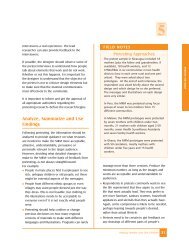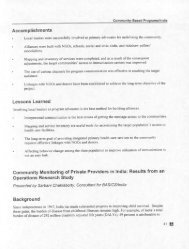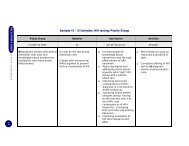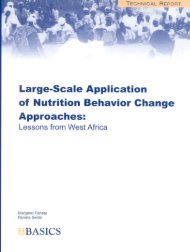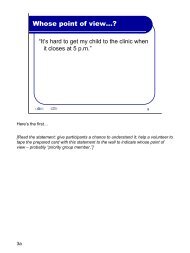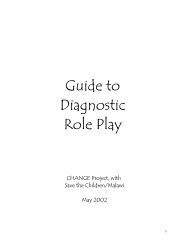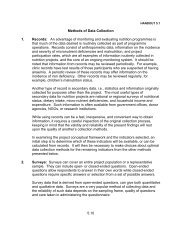MODULE TWO: COUNSELLING - FHI 360 Center for Global Health ...
MODULE TWO: COUNSELLING - FHI 360 Center for Global Health ...
MODULE TWO: COUNSELLING - FHI 360 Center for Global Health ...
Create successful ePaper yourself
Turn your PDF publications into a flip-book with our unique Google optimized e-Paper software.
A negative result can mean one of two things….<br />
♦The person has not been infected with the HIV virus; or<br />
♦The person has been infected within the last 3-6 months, and the body<br />
has not yet developed antibodies. If this is the case, then the person<br />
should be rested again in another 3 months, during which time they<br />
should avoid putting themselves and others at risk of HIV infection.<br />
An indeterminate result means that it is not possible to tell if the person has<br />
been infected with HIV based on the test results. In other words, the results are<br />
inconclusive. This does not occur very often, but it can happen to people who….<br />
♦Have had multiple pregnancies or miscarriages<br />
♦Have received multiple blood transfusions<br />
♦Have recently received an organ transplant<br />
♦Suffer from other autoimmune diseases, such as lupus or Grave’s<br />
disease<br />
♦Suffer from kidney disease or are receiving dialysis treatment<br />
♦Suffer from liver disorders<br />
♦Suffer from some types of cancer.<br />
People who receive indeterminate results should be re-tested again in three<br />
months if they have engaged in HIV risk behaviours. Those who are at low risk<br />
of HIV infection may not need to be re-tested.<br />
Callers may experience a range of emotions upon learning their test results.<br />
Many of these emotions will be very strong and should be acknowledged by the<br />
counsellor. A caller who is very emotional, either in a positive or negative way<br />
may be too distracted to hear in<strong>for</strong>mation that is given to them. There<strong>for</strong>e, it is<br />
important to help the caller to explore his/her emotions and “vent” them. Once<br />
a caller has released his/her feelings, s/he will be more receptive to receiving<br />
other in<strong>for</strong>mation regarding prevention, treatment and referrals.<br />
Counsellors should always acknowledge a caller’s feelings – both those that are<br />
directly expressed and those that are “unsaid”. Have participants refer back to<br />
the Focus on Feelings handout from Session 4 in order to identify feelings which<br />
might accompany the three types of test results. Following are examples of<br />
feelings which callers might experience upon receiving the different types of test<br />
results:<br />
Test result<br />
Negative<br />
Feelings<br />
Relieved; happy; ecstatic; unburdened; sad (if partner is<br />
infected and the caller feels guilty);<br />
Session 6 – Pg. 6



